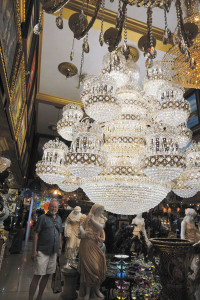In the past I’ve told you that my sister Gail and I take a trip together, just the two of us, every five or six years. Well, we decided to include our younger brother Mark and go a year and a half ago to visit her in Oakland, California. We had meant to take him on a trip four years ago when he turned 60 but schedules did not work out. Mark lives in Irvington and has delivered our newspapers. This is Day 8 (the last day) of an 8 day trip.
After two glorious days at Hearst Castle (going on all four tours they offered) we headed back to San Fran for one last day before returning home to Indianapolis.
San Francisco is one of those places you can visit a dozen times and still not see it all. I have been on several trips before and seen a lot, but we wanted our brother Mark to experience some of the high points.
Since this had been an architectural vacation we visited one of my architect sister Gail’s favorite buildings in Oakland, where she lives. The Cathedral of Christ the Light which was built by Craig Hartman of SOM (an architectural firm my sister had worked for for many years). The huge cathedral has an unusual shape like that of a bishop’s miter with two giant circles overlapping with wood and glass panels reaching upward, letting light filter in as if through a forest of redwoods — magnificent! Besides the usual sanctuary, rectory and conference center, it has a free health clinic and on the lower level a beautiful mausoleum for the bishops and members of the diocese.
After a ride past the Golden Gate Bridge for a good photo op, we headed to Chinatown. It’s the oldest Chinatown in North America and the largest Chinese enclave outside Asia, established in 1848. I love Chinatown and could spend days there. The variety of shops and prices are crazy — you can buy a little souvenir for less than a dollar in one shop next to a shop with prices in the tens of thousands — it’s incredible. There was a gigantic chandelier (I wish I could remember the price) with my brother standing below to the left in the photo to the right. That store was actually liquidating everything and the prices were so good I wish it wouldn’t have cost an arm and a leg to ship stuff back to Indy. I did buy a few small items for gifts to family back home.
The streets in Chinatown are bustling with activity all the time and my sister stopped to learn a tune from a street musician — the place is so much fun. Also as you stop to cross intersections you will hear people speaking languages you don’t recognize. The food is very affordable — lots of competition — and so delicious we had lunch there!
Next stop, the famous Cliff House (restaurant) perched on top of cliffs overlooking the ocean. The Cliff House has had six major incarnations since it was built in 1858. Samuel Brannan, a prosperous ex-Mormon elder from Maine, paid $1,500 for lumber salvaged from a ship that foundered on the rocky shore’s cliffs near Seal Rocks and built the first Cliff House. Then in 1896 it was rebuilt into a 7-story Victorian chateau. This was the same year work began on the famous Sutro Baths in a small cove immediately north of the restaurant near the beach. The baths included six of the largest indoor swimming pools, a museum, and a skating rink. After surviving the 1906 earthquake, Cliff House burned to the ground in 1907. After the fire, the restaurant was rebuilt again in a neo-classical style. It is basically what you see now. In 1914, the guidebook Bohemian San Francisco described it as “one of the great Bohemian restaurants of San Francisco.” Many famous people, including three presidents, visited Cliff House. The baths burned in 1966 and the lower level of Cliff House housed a museum of 20th-century penny arcade games which I saw years ago on my first visit to San Francisco (now moved to Fisherman’s Wharf).
We enjoyed walking around the grounds and from the back deck we watched the sun go down on our last evening on the West Coast.
As we drove back to my sister’s house we stopped in Golden Gate Park to see the Dutch Windmills built in 1903. Back in the late 1800s the Golden Gate Park was planted on a sand dune and needed a lot of irrigation to keep the thousands of plantings alive, so in 1902 the Park Commission had two windmills built to pump groundwater (they pumped 30,000 gallons of water per hour). Later electric pumps replaced the need for the windmills. In 1981 they were restored and now have beautiful gardens surrounding them.
Goodbye San Francisco!




